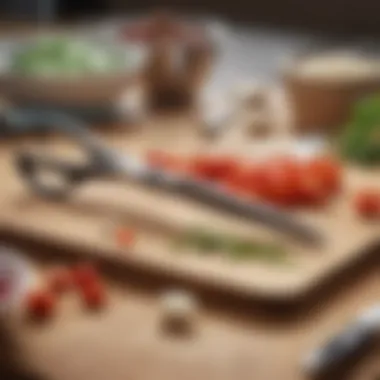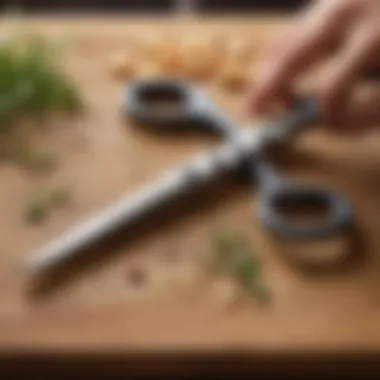Understanding Kitchen Shears vs. Scissors for Cooking


Intro
In the bustling arena of any kitchen, tools are more than mere objects; they are extensions of one’s creativity and skills. Among these essential tools, kitchen shears and scissors often find themselves confused or interchanged. While at first glance they may appear quite similar, a deeper look unveils distinct roles tailored to unique culinary needs. Understanding these differences isn’t just for culinary enthusiasts; it’s for anyone who wishes to elevate their kitchen game while ensuring safety and efficiency.
Kitchen shears are designed for a set of tasks that often involve heavier-duty use, like snipping herbs, cutting through poultry bones, or even opening packages. Their thick blades and ergonomic handles are crafted to provide a sturdy grip, allowing for the precise application of force. Scissors, on the other hand, are lightweight and more suited for intricate tasks such as trimming parchment paper, cutting twine, or maybe even particular trimming jobs in food crafting.
This article aims to dissect the unique functionalities, designs, and optimal usages of kitchen shears and scissors. By understanding when to each employ tool, you can make informed decisions that not only enhance your culinary experiences but also contribute to a safer cooking environment. So, let’s peel back the layers and explore the nuances that set these two cutting companions apart.
Intro to Kitchen Tools
Understanding the landscape of kitchen tools is key in mastering culinary skills. From chopping and slicing to measuring and mixing, these instruments play a pivotal role in how efficient and enjoyable cooking can be. As anyone who has embarked on a cooking journey knows, having the right tools makes all the difference. Yet, with a vast array of items available, it can be daunting to navigate through them and determine which ones are truly essential for your kitchen arsenal.
In this article, we aim to clarify some common misconceptions about tools, particularly kitchen shears and scissors. While they might seem interchangeable on the surface, each serves unique functions that cater to different culinary needs. By honing in on the distinct characteristics of these instruments, we can provide you with a clearer roadmap for your culinary adventures.
Why is it important to grasp these differences? Well, understanding how each tool is designed and its intended uses not only enhances your cooking efficiency but also promotes safety. Imagine trying to sever a package of raw chicken with scissors that were built for paper—an accident waiting to happen. Ultimately, this knowledge enriches your cooking experience; the more informed you are, the more confident you will be in your kitchen choices.
Understanding the Basic Tools of the Kitchen
In any kitchen, tools can be categorized based on their specific purposes. Think of them as the unsung heroes of your culinary journey. Here are some fundamental types:
- Knives: From chef's knives to paring knives, each has its unique purpose, primarily for cutting ingredients based on size and texture.
- Measuring Tools: Accurate measurement is crucial; hence, you have spoons, cups, and kitchen scales to nail down the numbers of your recipes.
- Mixing Bowls: Good for everything from tossing a salad to preparing batter, you can't do much without these.
- Cookware: Ovens, stoves, and frying pans help turn raw ingredients into delightful dishes.
When it comes to cutting tools, kitchen shears and scissors often fall into the mix, but their utility in food preparation often goes overlooked. By delving deeper into these two, understanding their manufacturing, handling, and practical applications becomes necessary.
In summary, the broad range of kitchen tools available not only aids in creating meals but also broadens your culinary creativity. Each tool demands respect and understanding—a proper relationship brings harmony to cooking, allowing for a more enriching experience. The journey of learning about kitchen shears versus scissors is just beginning. As we explore their history and functionality, you'll discover how to make informed choices that suit your culinary pursuits.
Defining Kitchen Shears
In the realm of culinary tools, kitchen shears stand out as a unique and indispensable accessory, distinct from traditional scissors. Their role is not merely interchangeable; kitchen shears have gradually carved out a niche that speaks to functionality and versatility in the kitchen. They serve a range of purposes and are engineered specifically to handle food-related tasks, making them a must-have for both amateur cooks and seasoned chefs alike. Understanding what kitchen shears are and their key attributes is critical for anyone looking to optimize their cooking experience, as this knowledge can dramatically influence effectiveness and safety in food preparation.
Historical Context and Development
The origins of kitchen shears can be traced back several centuries, adapting from conventional scissors that were stitched predominantly for fabric and paper. Traditionally, shears were crafted by skilled blacksmiths, who would forge robust blades capable of withstanding the rigors of daily kitchen use. Over time, as culinary practices evolved, so did the design and utility of shears. The shift towards specialized culinary tools was influenced by the growing complexity of food preparation techniques around the world. Thus, modern kitchen shears have now evolved to include various enhancements tailored for specific tasks, combining practicality with convenience.
Design Features
Kitchen shears are a prime example of how thoughtful design can directly elevate culinary practices. Understanding their design features can enhance their use and maintain efficiency during cooking.
Handle Ergonomics
Handle ergonomics is a focal point of kitchen shear design, catering to the natural grip of the hand. The design is crucial for comfort during prolonged use, reducing the fatigue one might experience. Kitchen shears often feature cushioned handles that fit snugly in the palm, allowing for a comfortable and controlled grip. This adaptability makes them particularly appealing for tasks such as cutting through thick meats or trimming herbs. An important characteristic of ergonomic handles is their ability to absorb pressure, providing not just comfort but also enhancing the precision of each cut. This thoughtful aspect of kitchen shears considerably benefits culinary enthusiasts who often find themselves engaging in repetitive tasks requiring sustained hand strength.
Blade Construction
The blade construction of kitchen shears is another vital aspect contributing to their effectiveness. These blades are typically made from high-carbon stainless steel, which combines sharpness with durability. The advanced metallurgical processes used in manufacturing ensure that the blades are not only sharp but also resistant to rust and wear, which is a fundamental requirement in a bustling kitchen environment. A notable feature here is the dual-blade design found in many shears, allowing for greater cutting power and flexibility. This versatility is especially advantageous when handling various types of food, from cutting through poultry bone to snipping herbs. However, one disadvantage worth mentioning is that the sharpness can diminish over time, necessitating proper maintenance and sharpening as part of care practices.
Integrated Tools
An intriguing feature of many kitchen shears is integrated tools, which often includes elements like bottle openers, nutcrackers, or even measurements marked on the handles. This multifunctionality is particularly beneficial in a kitchen setting where space and efficiency are at a premium. A key characteristic of these integrated tools is their ability to perform tasks that would usually require separate tools, saving both time and effort. While this added functionality can be seen as a significant advantage, it may also complicate cleaning, as the integration of various tools might hinder thorough sanitization if not designed effectively.


Common Uses in Culinary Practices
Kitchen shears shine in their practical applications within culinary settings. Their unique designs foster a variety of uses that extend beyond mere cutting.
Cutting Herbs
One of the most straightforward tasks that kitchen shears excel at is cutting herbs. The precision and sharpness of the blades allow users to obtain clean cuts without bruising the delicate leaves, retaining essential oils and flavors. This characteristic has led to their popularity, especially among those who frequently incorporate fresh herbs into their cooking. Additionally, using shears to snip herbs directly into dishes can reduce the mess associated with traditional cutting boards, providing convenience and expediting the prep time.
Trimming Meat
Another significant application of kitchen shears lies in trimming meat. Their robust design and sharp blades make it easier to navigate through tough skin or connective tissue that might frustrate regular knives. Many chefs appreciate the additional leverage that kitchen shears provide, enabling more aggressive slicing or cutting techniques when dealing with various types of meats. The efficiency gained in such delicate tasks highlights their foundational role in a well-equipped kitchen. However, it’s crucial to utilize shears designed specifically for meat, as plastic or light-duty shears may not hold up to rigorous use, leading to potential mishaps.
Opening Packages
Finally, opening packages is a common yet often overlooked use of kitchen shears. In the age of online grocery shopping, the ability to swiftly slice through plastic and cardboard is invaluable. Kitchen shears excel at this due to their sturdy design, making it easy to tackle tough packaging without risking damage to the contents inside. This functionality proves particularly useful when engaged in a busy cooking session, allowing for smooth transitions between tasks. Despite the utility provided by shears in this context, it’s essential to remember that not all shears are suitable—using them to open tough clamshell packaging can dull the blades, leading to more work down the line.
Defining Scissors
In the exploration of kitchen tools, scissors hold a unique place. While often seen as an everyday object, their role in the kitchen is multifaceted. Understanding scissors is essential not only because they have distinct functionalities but also because they possess unique design elements that contribute to their effectiveness across various tasks. Unlike kitchen shears, which are tailored for culinary applications, scissors provide versatility beyond the kitchen. Given the interplay between utility and design, dissecting the nature of scissors can illuminate their appropriateness for specific tasks in both food preparation and other settings.
Historical Context and Development
The history of scissors dates back thousands of years, tracing their roots to early designs made from bronze and iron. These initial versions were rather rudimentary, resembling more closely two metal blades that pivoted around a central axis. Ancient Egyptians were among the first to use them, primarily for cutting hair and textiles. Over time, the introduction of new materials has transformed scissors into the effective tools we know today. The standardization of size and the introduction of softer handles changed how scissors were perceived and utilized. Modern scissors, with dual blade designs and varied shapes, address a broader range of tasks, from crafting to cooking.
Design Features
Blade Shape and Length
When considering scissors, blade shape and length are pivotal. Typically, standard kitchen scissors feature blades that are longer and narrower compared to kitchen shears. This specific design allows for precision cuts, particularly useful for cutting through paper, fabric, and some delicate foods. The sleek shape reduces resistance and enhances control, making these scissors highly preferred for tasks beyond simple cutting. However, the length can limit their effectiveness in some culinary scenarios where strength is essential, thus rendering them less favorable than shears.
Pivot Point
The pivot point is a crucial element of scissors, influencing how smoothly and easily they operate. A well-designed pivot provides balance, enabling the user to apply force with minimal effort. This is particularly beneficial when cutting through thicker materials like cardboard or tougher food preparations. The positioning of the pivot can also dictate the force distribution across the blades. However, if the pivot is placed incorrectly or of inferior quality, it can lead to strain on the user's hands, reducing overall efficiency.
Materials Used
Materials play a significant role in the performance and longevity of scissors. Stainless steel is often the go-to material for blades due to its resistance to rust and corrosion, essential in culinary environments. Handles can vary from plastic to metal, each offering different levels of comfort and grip. High-quality scissors often utilize rubber grips to prevent slipping and improve control. However, the choice of materials can sometimes come with trade-offs; for example, while plastic handles may be lighter, they are not necessarily as durable as their metal counterparts.
Common Uses in Cooking and Beyond
Cutting Paper and Fabrics
One prominent use of scissors is cutting paper and fabrics, a function vital in culinary settings as well as in crafting. The ability to make precise cuts enhances not only recipe creation but also presentation elements. Experienced cooks often utilize scissors to cut parchment paper or twine directly in the kitchen, streamlining the process. This versatility makes scissors a common sight in kitchens and craft rooms alike.
Simple Food Preparation
In cooking, scissors can simplify food preparation tasks. They can be invaluable when cutting herbs directly from their stems, or snipping leafy greens to specific sizes. This method often provides a quicker alternative to knives for certain tasks and can reduce the number of utensils needing cleaning afterwards. While not all cooking tasks can be effectively managed with scissors, for some simple preparations, they are distinctly useful.
Decorative Cutting Techniques


Lastly, decorative cutting techniques showcase another aspect of scissors. When it comes to garnishing dishes or creating visually appealing presentations, the precision of scissors can do wonders. They allow for intricate designs in cheese or fruits, elevating any dish's aesthetic appeal. This ability to craft can be a game changer, particularly in catering or festive cooking environments, where presentation is key.
Key Differences Between Kitchen Shears and Scissors
Understanding the differences between kitchen shears and scissors is pivotal for anyone who spends time in the kitchen. Both tools might look similar at first glance, yet their distinct functionalities, designs, and intended uses can greatly affect your culinary experience. Knowing when to use each can enhance efficiency and safety, ensuring that food preparation is not only effective but also enjoyable.
Functionality
The functionality of kitchen shears versus scissors lays the groundwork for their appropriate use. Kitchen shears generally serve a broader purpose in culinary tasks, designed not only for cutting but also for splitting, snipping, and even cracking certain foods like nuts. With their larger blades and heavier frames, these shears can handle tougher ingredients such as poultry or herbs with ease. They often include additional features like bottle openers or screwdrivers built into their design, making them a versatile addition to your kitchen arsenal.
On the other hand, scissors are more specialized in their intended use. While they can cut through thin foods like parchment paper, herbs, or delicate vegetables, they lack the sturdiness of kitchen shears. Their sleek design allows for precision in tasks that require finesse, such as cutting intricate shapes from paper or fabric, but they may struggle with heavier duties.
In summary, if you are prepping a hearty meal that involves a variety of techniques, reaching for kitchen shears is often the wisest choice. But for tasks that require meticulous cutting or trimming, scissors may prove to be advantageous, despite their limitations in the kitchen.
Ergonomic Considerations
Ergonomics play a substantial role in the effectiveness of tools, especially in a busy kitchen. Kitchen shears typically boast generous, cushioned grips designed for comfort, promoting an easy handling experience even during extensive use. The positioning of the blades also allows for a natural hand movement, reducing fatigue during repetitive tasks. Their design can accommodate both left- and right-handed users, making them user-friendly for everyone.
Scissors, conversely, come in various designs that focus on precise cuts, often featuring thinner handles. This can lead to discomfort after prolonged use, particularly if the scissors are not well-suited for the user’s hand size. Furthermore, the lack of an ergonomic grip may result in slippage or strain on the fingers, especially for tasks requiring significant force. Thus, while scissors are splendid for light and precise cutting jobs, they may not fare well during extended culinary sessions.
"Ergonomic design isn’t just a buzzword; it signifies comfort and efficiency in the kitchen where time spent preparing can wear on even the best chefs."
Safety and Design Implications
When it comes to safety, the inherent design differences between kitchen shears and scissors are crucial. Kitchen shears are built with safety in mind, often featuring blunt tips to minimize the risk of accidental punctures when reaching into a drawer or while slicing through ingredients. Their overall heavier design provides stability, reducing the chances of slipping while cutting through tougher materials. This can be particularly advantageous when handling meats or hard shells—the shears provide the necessary power without compromising safety.
Scissors, however, present a different safety profile. Their pointed edges and finer blades are adept at precision but can cause injury if mishandled, especially when used on food items. Their lightweight design can lead to a lack of control, particularly among less experienced cooks. Using scissors in a kitchen context without clear intention could lead to accidents, particularly with sharp blades ready to nip.
Navigating these differences can empower cooks of all experience levels to choose the right tool for each task.
Practical Guidelines for Choosing Between the Two
When it comes to outfitting your kitchen with the right tools, a thoughtful approach can save both time and effort. The distinction between kitchen shears and scissors shouldn't only dwell on personal preference; choosing the right tool can impact your culinary outcomes. It’s crucial to navigate through various factors to ensure maximum efficiency during food preparation.
Assessing the Task at Hand
The first step in making a choice between kitchen shears and scissors lies in understanding the specific task at hand. Each tool possesses particular strengths suited to various tasks. For instance, those shears built with thicker blades and serrated edges are perfect for snipping fresh herbs. If you're trimming meat or cutting through poultry, their design allows for greater control and strength. In contrast, scissors shine when the task involves delicate operations, like trimming baking parchment or cutting through paper patterns for food presentation.
- Shears are ideal for:
- Scissors excel in:
- Trimming herbs, such as cilantro or chives.
- Cutting through bones or thicker meat joints.
- Opening packages or plastic wrappings with ease.
- Precision tasks, like cutting out recipes or decorations.
- Handling thin and lightweight ingredients, such as slicing soft cheese.
- General household uses beyond the kitchen, like crafting.
Considerations for Kitchen Setup
Your kitchen environment plays a pivotal role in which tool you will find most useful. If your space is limited, having versatile tools becomes paramount. Kitchen shears often serve multiple functions, eliminating the need for several separate gadgets cluttering your drawers. This is particularly beneficial in a smaller kitchen where counter space is at a premium. Conversely, if you have space to spare, you might opt for both, allowing you to be better prepared for varied culinary tasks.
Think also about how often you engage in different types of food preparation. If you're consistently tackling recipe after recipe that calls for cutting fresh herbs or shaping delicate ingredients, having dedicated scissors could be advantageous. Similarly, should you find yourself doing more extensive meal prep involving meats and vegetables, investing in a solid pair of kitchen shears might streamline that process comfortably.


Quality Versus Convenience
In today’s fast-paced world, convenience often prevails over quality—yet this perspective can lead to pitfalls in the kitchen. While it may be tempting to purchase the cheapest option readily available, this often results in tools that underperform. Investing in a high-quality pair of shears or scissors can yield benefits that quickly outbalance the initial expense.
Quality considerations should incorporate:
- Material: Stainless steel blades tend to retain sharpness longer and resist rust, making them more reliable in food prep.
- Ergonomics: Comfort during use can make a significant difference. Handles should feel right in your hand, preventing fatigue.
- Maintenance: Look for tools that allow for easy cleaning and sharpening, ensuring longevity.
Ultimately, while convenience might save you a few minutes today, a well-chosen tool often pays dividends in performance and durability down the line.
"Investing a little more in quality can save you a lot of trouble in the long run."
These practical guidelines not only solidify your understanding of kitchen tools but also enhance your overall cooking experience. By discerning when to reach for shears versus scissors, you'll make cooking more enjoyable, efficient, and safe.
Maintenance and Care
Caring for the tools that enhance our culinary artistry is paramount. Just as a painter tends to their brushes, a chef must likewise keep their kitchen tools, like scissors and shears, in prime condition. Not only does proper maintenance extend the life of these tools, it also ensures that they perform at their best. When we dive into the specifics of cleaning, sharpening, and storage, we touch upon the art of utilizing every cut wisely and securely.
Cleaning and Sanitizing
Kitchen hygiene cannot be taken lightly. With every meal prepped, kitchen shears and scissors gather a mix of oils, juices, and occasionally, bits of food. Regular cleaning not only keeps them looking sharp but also minimizes the risk of contamination. Here are some practical steps to keep in mind:
- Hand-Washing Is Key: While many believe tossing shears or scissors into the dishwasher is efficient, it can degrade the blades over time. Instead, use warm, soapy water and a soft cloth to wipe them down. Pay close attention to the hinges and any spaces where food particles might cling.
- Sanitize Regularly: After a thorough wash, it's advisable to sanitize. A simple solution of water and vinegar or a commercial kitchen sanitizer can work wonders. Just remember to rinse well and dry immediately to prevent corrosion.
Sharpening Techniques
A dull blade is like a painter with a worn-out brush; precision is lost. Maintaining the sharpness of your kitchen shears and scissors not only makes the work easier but safer. Here’s how to keep them sharp:
- Use a Whetstone: This traditional method requires patience. A few swipes at the right angle ensures blades maintain their edge. Make sure to follow the manufacturer’s instructions, as different blades may have varying requirements.
- Employ a Rod or Ceramic Sharpener: If you prefer something quick, a rod often does the trick. A few careful strokes against the blade can recover its cutting prowess.
- Professional Sharpening: For those who may not feel up to the task, seeking help from a professional could be a better choice. Some local shops offer this service, ensuring your tools are expertly sharpened, thus prolonging their life and effectiveness.
Storage Solutions
Proper storage is sometimes overlooked but is crucial for maintaining the integrity of kitchen tools. Here’s how you can keep your shears and scissors safe:
- Magnetic Strips: This is a fantastic way to keep shears and scissors visible and within reach. It helps reduce wear from being tossed into kitchen drawers.
- Sheath or Blade Guard: Using a sheath or a simple blade guard can protect the edges and decrease the risk of accidental cuts.
- Drawer Insulators: If you must store them in drawers, consider drawer organizers. Keeping them separated from other tools prevents blades from dulling due to friction.
"A chef’s art lies not only in the cooking but in how well they preserve and maintain their tools. Investing time in care today can yield culinary delights tomorrow."
Culmination and Final Thoughts
In wrapping up our exploration of kitchen shears and scissors, it becomes clear that both tools serve essential, yet distinct roles in the culinary realm. Understanding these differences not only elevates one’s cooking experience but also enhances safety and efficiency within the kitchen.
Recap of Key Points
The characteristics of kitchen shears and scissors differ in several notable ways:
- Functionality: Kitchen shears are specifically designed for food-related tasks, making them more versatile for various culinary duties like cutting through poultry or snipping herbs. Scissors, on the other hand, have a broader application beyond the kitchen, which can sometimes lead to less than ideal results when used with food.
- Design Elements: Shears are typically sturdier, often featuring thicker blades and ergonomic grips tailored for repetitive actions in food prep. Scissors lean towards finer, more delicate construction suitable for lighter materials.
- Maintenance: Given their intensive usage, kitchen shears require regular care, including sharpening and cleaning, to ensure optimal performance. Scissors, generally used less frequently in food preparation, might not demand as rigorous a maintenance routine.
Encouraging Informed Choices in the Kitchen
Encouraging informed choices means recognizing not just the tools at our disposal but understanding their intended functions. Selecting between kitchen shears and scissors should hinge on the task at hand and individual cooking style. Kitchen enthusiasts can consider the following:
- Evaluate Your Needs: Assess the meals you prepare regularly. If your cooking often involves trimming meat or slicing through layers of thick plastic packaging, investing in high-quality kitchen shears might be worthwhile.
- Safety First: Always prioritize safety by choosing the right tool for each task. Misusing scissors for food prep can heighten the risk of accidents. Instead, embrace shears where necessary.
- Enhance Your Culinary Skills: Over time, experimenting with both tools in appropriate contexts can lead to greater culinary proficiency. Each tool can contribute uniquely to your kitchen skills, expanding your repertoire.
"The right tools can make the difference between a culinary chore and a joyful task. Choose wisely!"
Every cook has a unique journey, but adding the right tools to your culinary inventory, be it kitchen shears or scissors, leads to better outcomes. Ultimately, making informed choices grounded in an understanding of these distinctions will not only streamline your cooking process but also enhance your enjoyment of food preparation.















